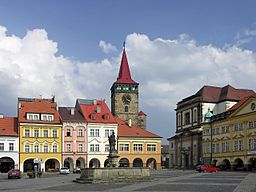Jicin
| Jičín | |||
| Town | |||
|
|||
| Country | Czech Republic | ||
|---|---|---|---|
| Region | Hradec Králové | ||
| District | Jičín | ||
| Commune | Jičín | ||
| River | Cidlina | ||
| Center | Wallenstein's Square | ||
| - elevation | 287 m (942 ft) | ||
| - coordinates | 50°26′12″N 15°21′6″E / 50.43667°N 15.35167°ECoordinates: 50°26′12″N 15°21′6″E / 50.43667°N 15.35167°E | ||
| Area | 24.93 km2 (9.63 sq mi) | ||
| Population | 16,426 (2006-10-02) | ||
| Density | 659/km2 (1,707/sq mi) | ||
| First mentioned | 1293 | ||
| Mayor | Jan Malý | ||
| Timezone | CET (UTC+1) | ||
| - summer (DST) | CEST (UTC+2) | ||
| Postal code | 506 01 | ||
| Statistics: statnisprava.cz | |||
|
Website: www |
|||
Jičín (Czech pronunciation: [ˈjɪtʃiːn]; German: Titschein, Gitschin or Jitschin; Latin: Gitmiacinum, Gitzinum;Polish: Jiczyn) is a town in the Hradec Králové Region of the Czech Republic. It lies approximately 85 km northeast of Prague in the scenic region of the Bohemian Paradise (Český ráj) under the Prachov Rocks (Prachovské skály).
Jičín has been declared a Municipal Reserve (městská památková rezervace) because of its well-preserved historical center, built around a rectangular square with a regular Gothic street layout, remnants of fortifications and arcade Renaissance and Baroque houses. The town is also connected with the popular fairy-tale character of Rumcajs.
The Battle of Gitschin was fought nearby during the Austro-Prussian War of 1866.
The surrounding countryside was settled by Slavic tribes at the beginning of the 6th century. The town of Jičín was probably founded at the end of the 12th century, in the place of today's village of Staré Místo (i.e. Old Place), under the castle of Veliš. It was moved two km northward to its present location shortly afterward, which was better protected by the Cidlina River. The first written reference of Jičín comes from a document by the wife of King Wenceslaus II of Bohemia, Queen Guta (Jitka), dated August 1, 1293. It is believed that the town was named after her (meaning Guta's town, Jitčino město in Czech). The town was built with a regular street layout around a rectangular square and was surrounded by wooden fortifications with reinforced bastions and a trench.
...
Wikipedia





